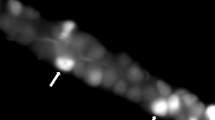Abstract
Ammonia is a cytotoxic substance liberated during Helicobacter pylori infection that may be responsible, in part, for the significant reduction in gastric acid secretion in human patients. However, it is not clear how ammonia blocks acid secretion. Here, we investigate several potential pathways for ammonia blockade in gastric oxyntic cells.___TAGSTART___BR___TAGEND___ Methods: Stomachs from the bullfrog, Rana catesbeiana, were stripped and mounted in Ussing chambers. Four possible pathways of blockade were investigated: (1) blockade of basolateral K+-channel activity, (2) blockade of ion transport activity, (3) neutralization of secreted H+ or (4) ATP depletion.___TAGSTART___BR___TAGEND___ Results: Addition of nutrient 10 mM NH4Cl at pH 7.4, yielding 92.5 μM NH3 and 9.91 mM NH4 +, abolished acid secretion within 30 min. Inhibition of acid secretion did not occur by blockade of basolateral K+-channel activity or ion transport activity, nor did NH4 + enter cells by substituting for Na+ or K+ on individual ion transporters. Furthermore, neutralization of the luminal solution by NH3 and/or ATP depletion cannot account for the total reduction in acid secretion. We demonstrate that NH4Cl acts specifically on stimulated tissues.___TAGSTART___BR___TAGEND___ Conclusions: We show that small concentrations of ammonia completely block gastric acid secretion. We propose that inhibition of acid secretion occurs by blockade of an apical K+-channel, specifically inwardly rectifying K+-channels. Our data suggest that apical K+-channel activity may be essential for the regulation of acid secretion and could be a new therapeutic target for acid inhibitory drugs.
Similar content being viewed by others
REFERENCES
Boron, W. F., Waisbren, S. J., Bodlin, I. M., et al. (1994). Unique permeability barrier of the apical surface of parietal and chief cells in isolated perfused gastric glands, J. Exp. Biol. 196, 347–360.
Del Valle, J. C., Olea, J., Pereda, C., et al. (1998). Sulfonylurea effects on acid and pepsinogen secretion in isolated rabbit gastric glands, Eur. J. Pharmacol. 343, 225–232.
Diaz, M., Riquelme, G. and Sepulveda, F. V. (1996). Ammonium inhibition of Ca2+ C-dependent inwardly rectifying K+ currents in HeLa cells, Biochim. Biophys. Acta 1284, 119–121.
Fryklund, J., Gedda, K., Scott, D., et al. (1990). Coupling of H+-K+-ATPase activity and glucose oxidation in gastric glands, Am. J. Physiol. 258, G719–G727.
Fujita, A., Horio, Y., Higashi, K., et al. (2002). Specific localization of an inwardly rectifying K+ channel, Kir4.1, at the apical membrane of rat gastric epithelial cells: its possible involvement in K+ recycling for the H+-K+-pump, J. Physiol. 540, 85–92.
Gingell, J. C., Burns, G. P. and Chisholm, G. D. (1968). Gastric acid secretion in chronic uraemia and after renal transplantation, Br. Med. J. 4, 424–426.
Hagen, S. J., Wu, H. and Morrison, S. W. (2000). NH4 Cl inhibition of acid secretion: possible involvement of an apical K+-channel in bullfrog oxyntic cells, Am. J. Physiol. 279, G400–G410.
Hrnjez, B. J., Song, J. C., Mayol, J. M., et al. (1997). Ammonia inhibits intestinal Cl¡ secretion via ammonium block of basolateral K+ channels, Gastroenterology 112, A370.
Hrnjez, B. J., Song, J. C., Prasad, M., et al. (1999). Ammonia blockade of intestinal epithelial K+ conductance, Am. J. Physiol. 277, G521–G532.
Knepper, M. A., Packer, R. and Good, D. W. (1989). Ammonium transport in the kidney, Physiol. Rev. 69, 179–249.
Mathur, K. P. and Agrawal, S. P. (1973). A study of the acid gastric secretion in portal hypertension, J. Indian Med. Assoc. 60, 288–291.
McLennan, W. L., Machen, T. E. and Zeuthen, T. (1980). Ba2+ inhibition of electrogenic Cl ¡ secretion in vitro frog and piglet gastric mucosa, Am. J. Physiol. 239, G151–G160.
Megraud, F., Neman-Simha, V. and Brugmann, D. (1992). Further evidence of the toxic effect of ammonia produced by Helicobacter pylori urease on human epithelial cells, Infect. Immun. 60, 1858–1863.
Mobley, H. L. T. (1997). Helicobacter pylori factors associated with disease development, Gastroenterology 113, S21–S28.
Murakami, M., Saita, H., Teramura, S., et al. (1993). Gastric ammonia has a potent ulcerogenic action on the rat stomach, Gastroenterology 105, 1710–1715.
Muto, S., Murayama, N., Asano, Y., et al. (1985). Hypergastrinemiaand achlorhydriain chronic renal failure, Nephron 40, 143–148.
Pacifico, A. D., Schwartz, M., MacKrell, T. N., et al. (1969). Reversal by potassium of an effect of bariumon the frog gastric mucosa, Am. J. Physiol. 216, 536–541.
Prasad, M., Smith, J. A., Resnick, A., et al. (1995). Ammonia inhibits cAMP-regulated intestinal Cl- transport: Asymmetric effects of apical and basolateral exposure and implications for epithelial barrier function, J. Clin. Invest. 96, 2142–2151.
Reenstra, W. W. and Forte, J. G. (1990). Characterization of K+ and Cl- conductances in apical membrane vesicles from stimulated rabbit oxyntic cells, Am. J. Physiol. 259, G850–G858.
Ricci, V., Sommi, P., Fiocca, R., et al. (1993). Cytotoxicity of Helicobacter pylori on human gastric epithelial cells in vitro: role of cytotoxin(s) and ammonia, Eur. J. Gastroenterol. Hepatol. 5, 687–694.
Sanders, S. S., Noyes, D. H., Spangler, S. G., et al. (1973). Demonstration of a barium-potassium antagonismon lumen side of in vitro frog stomach, Am. J. Physiol. 224, 1254–1259.
Sanders, S. S., Shoemaker, R. L. and Rehm, W. S. (1977). Electrogenic HCl theory in light of effects of SCN¡ and Ba2+ C on frog stomach, Am. J. Physiol. 234, E298–E307.
Schwartz, M., Pacifico, A. D., MacKrell, T. N., et al. (1968). Effects of barium on the in vitro frog gastric mucosa, Proc. Soc. Exp. Biol. Med. 127, 223–225.
Wolosin, J. M. and Forte, J. G. (1985). K+ and Cl¡ conductances in the apical membrane from secretingoxyntic cells are concurrentlyinhibitedby divalent cations, J. Membr. Biol. 83, 261–272.
Yanaka, A., Muto, H., Ito, S., et al. (1993). Effects of ammonium ion and ammonia on function and morphology of in vitro frog gastric mucosa, Am. J. Physiol. 265, G277–G288.
Rights and permissions
About this article
Cite this article
Hagen, S.J. Ammonia and gastric acid secretion: a key to understanding activity and regulation of the H+,K+-ATPase. Inflammopharmacology 10, 471–481 (2002). https://doi.org/10.1163/156856002321544936
Issue Date:
DOI: https://doi.org/10.1163/156856002321544936




